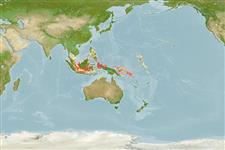>
Eupercaria/misc (Various families in series Eupercaria) >
Caesionidae (Fusiliers) > Caesioninae
Etymology: Pterocaesio: Greek, pteron = wing, fin + Latin, caesius = blue grey (Ref. 45335); monikae: Named for Lady Monika Bacardi...
Environment: milieu / climate zone / depth range / distribution range
экология
морской; пределы глубины 0 - 55 m (Ref. 74965), usually 0 - 15 m (Ref. 74965). Tropical
Western Pacific: Cenderawasih Bay, Indonesia.
Length at first maturity / Size / Вес / Возраст
Maturity: Lm 9.3, range 9 - 9.75 cm
Max length : 9.8 cm SL самец/пол неопределен; (Ref. 74965)
колючие лучи спинного плавника (общее число): 10; членистые (мягкие) лучи спинного плавника (общее число): 14-16; колючие лучи анального плавника 3; членистые (мягкие) лучи анального плавника: 11 - 12. This species is distinguished by the following set of characters: 2 post-maxillary processes; D X,14-15 (usually 15); A III, 11-12 (usually 12); pectoral rays 20-21(usually 20); lateral-line scales 72-80 (modally 74); scales above lateral line to origin of dorsal fin 6-7 (usually 7); scales below lateral line to origin of anal fin 12-14 (usually 13); circumpeduncular scales, anterior modally 12.14, ventral modally 14.71; body is fusiform in shape and extremely elongate for the genus, greatest depth 4.3-5.1 in SL; HL 3.2-3.6 in SL; snout 4.0-5.2 in HL; eye 2.9-3.6 in HL; pectoral-fin length 1.2-1.4 in HL; in life, color blue, grading to silvery white on belly, with prominent, broad yellow stripe on upper side from dorsal posterior margin of operculum to upper half of caudal peduncle, covering maximum of four scale rows, centered just above lateral line, except entirely above it on caudal peduncle; tip of each caudal-fin lobe with reddish spot (often appearing black underwater), before this is a whitish area (Ref. 74965).
A common species, occurring in large schools with up to several hundred individuals. Observed to be frequently mixed with Pterocaesio pisang and Gymnocaesio gymnopterus. Often occurs on the upper edge of seaward reef slopes, commonly at depths ranging from the surface to about 15 m, but also sighted as deep as 55 m. Unlike other caesionids, when pursued, it hides in nearby crevices and holes within the reef matrix (Ref. 74965).
Life cycle and mating behavior
половая зрелость | размножение | нерест | икра | Fecundity | личинки
Allen, G.R. and M.V. Erdmann, 2008. Pterocaesio monikae, a new species of fusilier (Caesionidae) from western New Guinea (Papua and Papua Barat provinces, Indonesia). aqua, Int. J. Ichthyol. 13(3-4):163-170. (Ref. 74965)
Статус Красного Списка МСОП (Ref. 130435)
Угроза для людей
Harmless
Использование человеком
дополнительная информация
Возраст/РазмерыростЗависимость между длиной и массой телаЗависимость между длинамиРазмерный составморфометрияморфологияличинкидинамика численности личинокпополнениечисленностьBRUVS
ссылкиаквакультура (рыбоводство)особенности рыбоводствастепень растяжениягенетикаElectrophoresesнаследуемостьболезниобработкаNutrientsMass conversion
соавторыизображенияStamps, Coins Misc.звукиCiguateraскоростьтип плаванияжаберная областьOtolithsмозгзрение
инструменты
Специальные отчеты
Скачать в формате XML
ресурсы в Интернет
Estimates based on models
Preferred temperature (Ref.
123201): 28.4 - 29.2, mean 28.8 °C (based on 329 cells).
Phylogenetic diversity index (Ref.
82804): PD
50 = 0.5002 [Uniqueness, from 0.5 = low to 2.0 = high].
Bayesian length-weight: a=0.01072 (0.00467 - 0.02458), b=3.12 (2.94 - 3.30), in cm total length, based on LWR estimates for this Genus-body shape (Ref.
93245).
Trophic level (Ref.
69278): 3.3 ±0.4 se; based on size and trophs of closest relatives
устойчивость к внешним воздействиям (Ref.
120179): высокий, минимальное время удвоения популяции до 15 месяцев (Preliminary K or Fecundity.).
Fishing Vulnerability (Ref.
59153): Low vulnerability (10 of 100).
